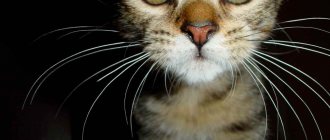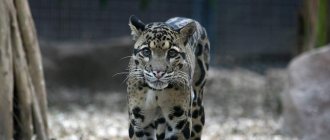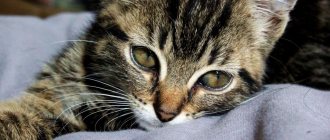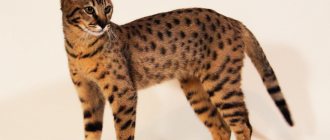Cats are one of the most mysterious mammals on Earth. It seems that they don’t need people, but they live next to us. However, they always keep their distance – and at the same time do not refuse to help. Cats have unusual abilities, and some of them cannot be explained scientifically - but nature does not create anything unnecessary. The origin of the mustachioed striped animals is also not very clear. All this and something else gives reason to believe that cats may well turn out to be representatives of extraterrestrial civilizations. Or maybe their descendants?
A little history
An interesting fact: the first evidence of cats appeared only after the Flood. There are many legends and myths about these animals; some of them claim that cats are actually creatures of the gods. And they were bred by crossing a lion with a monkey. Other epics say that cats “came on their own,” and no one knows where. Still other sources directly indicate that they descended from heaven.
The scientific world dates the appearance of these animals to the times of Ancient Egypt. Its inhabitants not only welcomed cats into their homes, but also treated them as sacred creatures. Temples were erected in honor of cats; after the death of the animals, they were embalmed and made into mummies.
The Egyptians probably knew more about cats than we do. According to the ideas of the ancients, these animals came to Earth as companions of the gods. Their original home was an unknown planet, illuminated by Sirius from the constellation Canis Major. There is evidence that some of the priests were confident in the existence of a certain civilization, whose representatives knew how to change the human form into a cat one. It is not for nothing that one of the goddesses of the ancient Egyptians, Bast, was depicted as a woman with the head of a cat.
In addition, the Egyptians either knew or suspected that even ordinary cats had some kind of superpowers. They were allowed to go to the most mysterious places of temples and pyramids, where even clergy were denied access. In order not to make it difficult for animals to move, small doors were made in the structures - a cat will pass through, but a person will not be able to.
As for the abilities of cats, they still baffle both ordinary people and scientists.
How many wild cats
It is impossible to determine how many wild cats there are in the world. One has only to imagine that the cat genus is more than 35 million years old and there are no less than forty species. They inhabit all continents, except that they are not in Antarctica. There are almost a million lynxes in the world alone. But the population of some felines, thanks to humans, is steadily falling, despite regular offspring. In just the last twenty years, the number of African lions has decreased tenfold, tigers have become catastrophically few - no more than 5 thousand on the entire planet. There are about 15 thousand Asiatic cheetahs, and the Russian snow leopard boasts an even lower number - two thousand individuals.
How do they know?
We can say that cats have excellent clairvoyance. Or some other, similar ability. Anyone who has ever had a cat can tell a story about how the pet suddenly woke up or was distracted from what it was doing and sat down in front of the front door, glaring at it. And soon a guest rang or knocked on the door. Suppose an animal, thanks to its keen hearing, heard footsteps on the stairs. However, how could it know that a person was going to this particular apartment? And the cat reacts exclusively to guests; other people can walk up the stairs around the clock, she won’t even move her ears.
There is plenty of evidence that cats can smell people who are up to no good. And they warn the owners about enemies: by hissing, attacks and choosing the shoes of an ill-wisher as a tray. It might be worth taking a closer look at the person whose shoes your cat regularly shits in. True, only if the victim is not a “dog person” - cats don’t like such people simply because of the hostile smell.
Natural cleaner
The tradition of letting a cat be the first to enter a new home was not born out of nowhere. Scientists have proven that mysterious animals can neutralize negative energy. True, they have not yet figured out exactly how. So the cat, having walked around the home, collects all the bad things that the previous residents or builders left behind. According to the observations of the owners, the cat lies down in a particularly “bad” place and does not leave it until it rids the space of negative energy.
An interesting theory has been put forward about this. They say that once upon a time, back in the time of the Atlanteans, cats were genetically modified by representatives of the legendary civilization (who, by the way, were quite possibly aliens too). After such manipulations, the animals deliberately looked for and collected negativity on themselves. There must have been a lot of it, because the cats began to get sick and die. Result: the lifespan of the “collectors” has been greatly reduced. According to legends, cats once lived for a hundred years. Nowadays, few representatives of this tribe even reach 20.
Who belongs to the cat family?
Cat family
- Clouded leopard
- Leopard
- a lion
- Ussuri (Amur) tiger
- South China tiger
- Bengal tiger
- White Tiger
- Panther
Aug 16
2022 Interesting materials:
How long is a criminal record certificate valid for applying for a job? How long is a certificate from a previous place of employment valid? How long is the Qiwi virtual card valid? How long does buyer protection last for Ali? How long do the List Olympics last? How long are Unified State Exam results valid? How many days is a bank check valid? How many days is a doctor’s certificate valid for kindergarten? How long has the Unified State Exam 2022 been valid? How many years does the novel Eugene Onegin last?
Built-in compass
The ability of cats to navigate completely unfamiliar terrain and find their way home remains inexplicable. In this regard, the cat Pino became especially famous. Its owner paid for the animal’s flight to his friend, who lived 200 kilometers from the owner’s place of residence.
After 11 days, Pino returned - injured, emaciated and dirty. The researchers' amazement was primarily caused by the cat's ability to determine the direction in which it should move. After all, after traveling by plane, he had no landmarks; he could not determine where he was taken.
Second question: how could a cat walk approximately 16 km a day? After all, he also needed to look for food for himself. And he moved through difficult terrain (from the animal’s point of view), overcoming highways, railway lines and populated areas.
It was agreed that cats have a kind of sixth sense. For some time scientists could not explain what it was based on.
Understanding of the process came after the research of F. Morel, a scientist from America. He focused on electronic techniques. In particular, he implanted electrodes connected to radio transmitters into the brains of experimental cats. The areas of the brain responsible for vision were studied.
The results were sensational: even with their eyes closed, the animals “saw.” Clarification: during the experiments, signals were heard at frequencies inaudible to the human ear. So scientists have found that the nerve cells of the cat's brain, which should respond only to signals received from the eyes, also respond to sounds. Moreover, the number of these cells is approximately half of the total volume. This ability was called ocular hearing. And cats are the only creatures on our planet who have it.
Optional equipment"
For quite a long time, humanity was firmly convinced that the main way cats obtain information is through vision. After all, they have it six times better than the most keen-sighted person. Cats effortlessly recognize an object at a distance of one hundred meters and can calmly and directly look at the sun. And it is true. The only misconception concerns the ability of animals to see in complete darkness. In the absence of at least weak lighting, cats switch to auditory orientation.
However, as it turned out, cats rely not only on hearing and visualization to determine their location in space. They have additional “equipment” that gives them an advantage over other animals, including humans. The cat's eyebrows, whiskers and hairs growing on the forelimbs are not purely aesthetic details.
Thanks to them, the animal will not be helpless, even if it finds itself in absolute silent darkness. In such a situation, the cat does not face any collisions with objects or problems determining the direction of movement. This fact has been scientifically proven: from a labyrinth with perfect sound insulation without the slightest ray of light, animals choose the most optimal route. But only until the mustache and eyebrows are cut off.
The most “catty” countries in the world. Which countries have the largest number of cats?
Today
200 million cats live in the nine "cat" countries.
Japan - 7.25 million cats
There are entire “cat islands” in Japan - Tashiro and Aoshima. On Tashiro Island there is a small cat sanctuary called Neko-jinja; the Japanese who come here consider it their duty to feed the local cats. According to legend, this brings good luck. On the island of Aoshima, the cat population is already 8 times higher than the human population, and local cats have long survived only at the expense of tourists. This is from open sources.
Photos from open sources
Germany - 7.75 million cats
In Germany, the number of stray animals is growing steadily – counting in the millions. The main reason is the free range of unneutered domestic cats. In 2014, the Germans estimated that stray cats caused damage to green spaces in cities worth 500,000 euros. The issue of stray cats was brought up for public discussion, but citizens of the country spoke out against the destruction of stray animals.
Photo from personal archive
UK - 7.75 million cats
Domestic cats live in many families and homes in the UK, including the Prime Minister's residence. British animal welfare laws are among the most advanced in the world. But nevertheless, there are also a lot of stray cats. 85% of kittens in England are born “over plan”. As a result, government expenses for maintaining cat shelters are increasing from year to year. Over the past few years, the population of cat shelters in England has grown to 40 thousand.
Photo from personal archive
Italy - 9.5 million cats
Cats in Italy enjoy a lot of privileges and are allowed to roam freely throughout the country, with many shelters and volunteers at their service. One of the most famous shelters for cats is Torre Argentina in Rome. Cats can freely come here to eat and rest, and then go on about their business. The Le Gattares movement – cat lovers – is widely developed in the country. These are groups of women who come together to feed homeless cats in their area and, if necessary, provide them with assistance.
Photo from personal archive
France - 9.5 million cats
France is a country where cat owners use them not only as pets, but sometimes as a fashion accessory, such as lap dogs. The country has strict rules for keeping pets, and all domestic cats must be registered in a national database. Each cat must have an identification mark on itself in the form of a tattoo or microchip with information about the owner. This partly helps the French in identifying stray cats (if they have escaped from home), but does not solve the problem of increasing the population of stray animals. Cases of attacks by stray cats on dogs and even people are regularly recorded in the country.
Photos from open sources
Brazil – 12.5 million cats
The lack of accurate statistics does not allow us to establish the real ratio of domestic and stray cats in this country. There is definitely a noticeable increase in the number of pets in this country - this can be seen in the dynamics of cat food sales. Over the 5 years from 2007 to 2012, sales grew by 37.6%, to $869 million per year. (Editor's note: By comparison, sales of cat food in Russia in 2015 amounted to more than $1 billion.)
Photo from personal archive
Russia – 12.5 million cats
Russians, for the most part, love pets very much. Cats live in many families, often in more than one. Among them there are relatively many outbred animals taken from the street. At the same time, Russia has its own world-famous breeds of domestic cats - for example, the Russian Blue (from the editor: also the Siberian, Neva Masquerade, Don Sphynx, Kuril and Mekong Bobtails, etc.). In addition to them, Russia is known for a significant population of stray cats roaming the streets of cities. At the beginning of 2015, the whole world was excited by the news about a stray cat Masha, who saved a newborn baby from death in Obninsk. A child abandoned in the entrance would certainly have frozen, but the cat warmed him with her body and called people for help.
Photo from personal archive
China – 53 million cats
China has the third largest market for pet products (after the US and UK. Russia ranks 5th, India 4th). But, parallel to the increase in the number of domestic cats, the population of stray cats is also growing. Thousands of stray cats roam the streets of Beijing. Stray cats create problems for the environment, cause the spread of diseases and cause road accidents. On the eve of the 2008 Olympics, many stray animals were destroyed in China. Most stray cats in this country are animals abandoned by their owners. The Chinese get rid of cats for various reasons: abandoning them when moving to a new place or kicking them out for fear of contracting a contagious disease like SARS. Luckily for cats, there are many organizations in China that help homeless animals. They help cats avoid painful death at the hands of local “Balloons” and urge the country’s authorities to use more humane measures to control the domestic animal population.
Photo from personal archive
USA – 76.5 million cats
In the United States of America, every third family owns cats, and each such family has an average of 2.2 cats. American cat owners often take additional cats into their home - from the street or from a shelter. Most Americans receive cats as gifts from family or friends, 34% pick them up on the street or at a shelter, and only 3% buy cats from breeders.
Photo from personal archive
- Previous: Vladimir is a Russian city full of interesting places
- Next: Dreams after the pandemic) 38 things you need to know before your first trip to Paris
Benefits for space
Another ability of cats was very useful to people when developing programs for the exploration of interstellar space. Where there is no gravity, it is extremely difficult for people to orient their bodies in space. The solution was suggested by cats, who, as you know, always land on their paws when they fall. Scientists filmed this process and studied it frame by frame. At the same time, they already knew that the position of the cat’s body is corrected by the tail, so they paid closer attention to the details.
As a result, it was established that during the fall of an animal, its tail makes rotational movements in the opposite direction relative to the rotation of the rest of the body. These manipulations are performed until the animal’s balance organs indicate that the head is in the correct position.
The last stage of landing is to align the cat's body. Here the tail acts as a stabilizer.
Man has no tail. Rotational movements of the legs were proposed as a replacement. The idea turned out to be brilliant: cosmonauts who had undergone training could take the position in space that they needed at the current moment.
Domestic cat statistics
According to research data, there are more than 400 million domestic cats in the world. It is impossible to determine exactly how many cats there are in the world, because their number is constantly growing. A sexually mature cat can give birth to up to seven kittens at a time, and owners do not always control this process, preventing the animal from becoming pregnant. The village murks, without asking or consulting anyone, regularly bring babies to their hem two or three times a year. Birth control of purebred individuals is carried out constantly. Some clubs monitor the purity of the breed and require their participants to agree on matings and their frequency. Expensive, elite animals such as the savannah are within very strict limits on fertility and produce no more than 200 individuals per year. Not everyone can afford such animals, but there is still a pre-registration for them. These cats are not mated just like that, in case a buyer is found.
Some oddities
Ufologist B. Steiger cites other features inherent in animals as evidence of the alien origin of the cat tribe. Among them are healing abilities, as well as the ability to anticipate troubles. Moreover, scientists were able to explain the prediction of natural disasters. But taking the owners out of the house before an attack by robbers or the arrival of a bomb is not. The mysterious intelligence of furry pets and their powers of observation are also mentioned. Some cat owners are sure that their pet can read minds. And it’s not at all a fact that this is hyperbole, suspiciousness or mild madness. It is quite possible that they can.
How does genetics influence
The relationship between breed and lifespan has not been scientifically proven. In some individuals, it is reduced due to a genetic predisposition to serious diseases: cardiomyoscopy, polycystic kidney disease, airway obstruction, and malignant tumors. Representatives of artificially bred breeds live on average 9–12 years. These include: Bombay; Abyssinian; exotic shorthair; snowshoe. The life of at-risk pets can be extended if you double your attention to health, take them to the veterinarian, and treat them promptly. Representatives of long-lived breeds are distinguished by strong immunity, rarely get sick and, with proper care, live up to 18–20 years. Among them are the following varieties: Siamese; oriental; American Shorthair; Manx; Egyptian Mau. Outbred cats develop strong immunity; they live up to 15–18 years if they find themselves in a home with caring owners.
Curious facts
* The idea that cats are of extraterrestrial origin is not new at all. Pharaoh Akhenaten, who abolished polytheism and tried to “popularize” the cult of Aten, declared cats to be his sisters and brothers, thereby equating them with gods. Which, by the way, flew from Sirius.
* A few centuries later, Pythagoras joined the opinion of the long-deceased pharaoh, calling cats “aliens from other spheres.” Later, the philosopher Plotinus, in one of his works, directly said that cats “fell from the moon.” And the Gnostics from Alexandria (for example, Bacchylides and Valentine) even awarded the mysterious animals the title “messengers of distant stars.”
* One can also recall church leaders who share this point of view. St. Augustine, in one of his treatises, called cats the inhabitants of the Heavenly City, the only creatures who are allowed to know the way both there and back.











